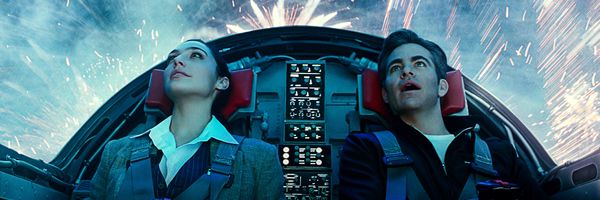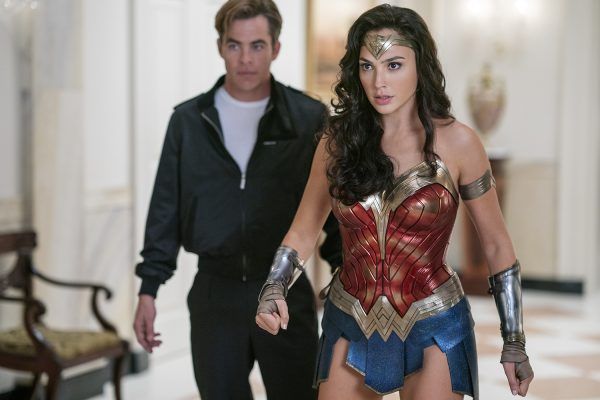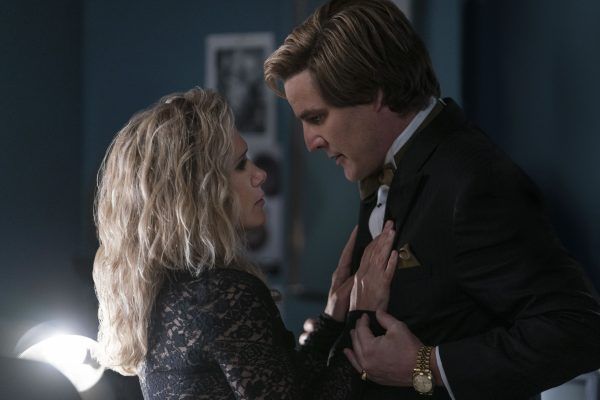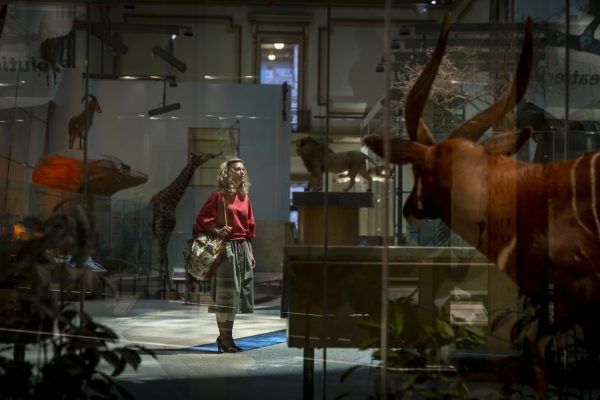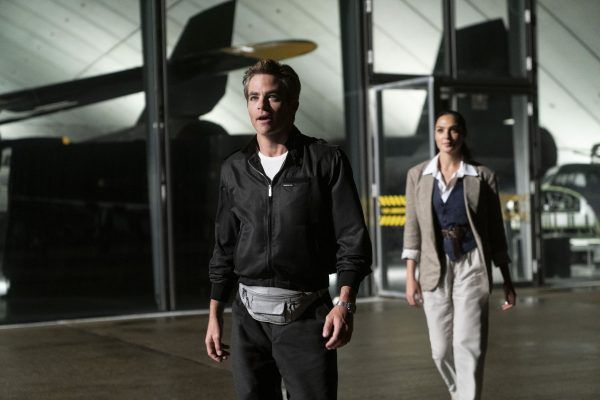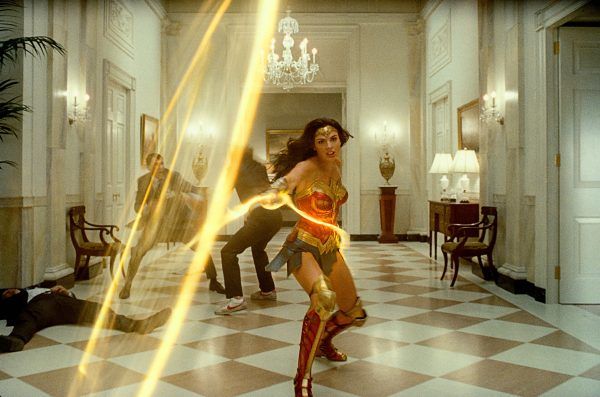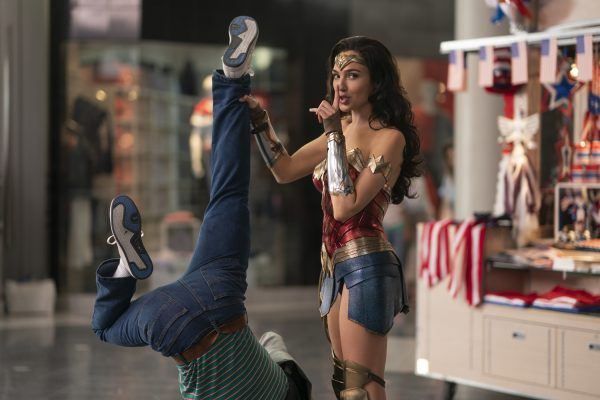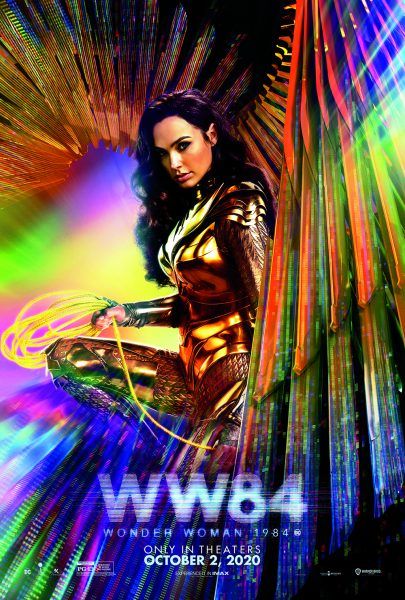The world of 2018 feels unrecognizable from our current point in time. We were just two years into Donald Trump’s U.S. presidency which beget the immigration crisis along the Mexican-American border, talk of collusion between Trump’s election campaign and Russian officials, the public-facing resurgence of white supremacy, and the height of the #MeToo movement. Wonder Woman 1984 director Patty Jenkins was thinking about this moment on the U.K. set of her sequel to 2017’s DC Comics blockbuster—like the rest of us, blissfully unaware that in just two years time a global pandemic would force the public into quarantined isolation, dismantle the U.S. economy, and lead to a situation where a sitting president supports withholding funds for the postal service to prevent mail-in voting.
At the same time, just as Jenkins was thinking about the world of 1984 in relation to 2018, the problems of the past maintain parallels to problems of the present.
In the ‘80s, a time of excess and drive to achieve the “American Dream,” “It was like we thought for sure it could go on forever and there was going to be no price and you could just [have] exponential growth,” the filmmaker says on the set of 1984. But, as Jenkins and her characters realized, there is a price. “I think in that way, we're talking about then and we're also talking about right now,” she adds. “We're talking about what we're dealing with right now because that struggle is very much alive in our own psyche.”
These days, Hollywood is still scrambling to figure out how to bounce back in the age of the COVID-19 pandemic. AMC Theatres plans to reopen American cinemas this week, but who knows what potential woes this will cause down the line in terms of the national infection rate. Still, at this point in time, Wonder Woman 1984 maintains its new Oct. 2 release date with a virtual DC FanDome event set for this Saturday, Aug. 22 to hype up the blockbuster event (and unveil a brand new trailer). Come what may, this climate offers the chance to share what Collider learned about the film direct from the set as we collectively are paying the price for past grievances.
- First of all, why the year 1984, specifically? Might it have something to do with author George Orwell’s futuristic dystopia? “We should have that conversation after you've seen the film,” producer Charles Roven In any case, 1984 “was at the peak of [America’s] power and its pride,” associate producer Anna Obropta mentions. “It was everything commercialism, passion, wealth, even violence was in excess. It was a decade of greed and desire.” In simpler terms, “it was humanity at its best and at its worst,” she says.
- Where do we find Ms. Diana Prince (Gal Gadot) in the year 1984? She’s in Washington, D.C. working in the anthropology and archeology department of the Smithsonian Museum of Natural History. “She’s slightly disengaged with the world and a bit lonely as the world whips around her,” Obropta Gadot says Diana “doesn’t really want to make close connections with anyone. She knows either she’s going to hurt them because she’ll have to disappear one day or she will lose them because they’ll grow old. After the loss of Steve and the entire team later on, I think Diana is in a place where she’s happy where she is. She’s fairly lonely, but she made the decision to do that.”
-
Who is the villain of this next chapter? Well, there are multiple antagonists, but the real enemy, one might argue, is capitalism. Gadot observes that Diana’s adversaries are not “obvious villains,” that she found herself rooting for them initially as much as she was rooting for Diana and Steve when reading the script. Game of Thrones’ veteran Pedro Pascal plays comic book villain Maxwell Lord, only in the context of the film he’s the president of Black Gold International. He’s the king of phony informercials. If people are chasing after dreams of wealth, power, and fame, then Max is selling those dreams. He is this “desperate, self-obsessed, fraudulent entrepreneur who runs a business selling the American Dream,” Obropta Barbara Minerva, another antagonist played by Saturday Night Live alum Kristen Wiig, is beguiled by this illusion and eventually corrupted by it. The character will begin her transformation into Cheetah, one of Diana’s most famous adversaries from comics canon, by falling victim to Max’s scheme. “At first look, it is a dream come true,” Obropta continues. Diana’s once timid, bookish gemologist friend at the museum now feels “feels physically stronger. She feels more seen and respected in the world, but her power takes a very fast, very dark turn as she transforms into this vicious and savage creature, like nothing we could have ever imagined.” Diana, meanwhile, sees all the greed and all the “bad things that that are being done in order to get to the top,” Gadot says. “I think she doesn't like that so much: the price that people are willing to pay in order to achieve whatever it is they want to achieve. But other than this, I think [Diana] loves the '80s. Great hair, she's rocking the hair and styles, it's great.”
- Expect parallels between Max and Trump. Photos of the fired reality TV star with a trail of bankruptcy filings adorn costume designer Lindy Hemming’s work space. “Donald Trump, of course,” she says, while discussing sketches for Max’s business attire. “Well, that’s helpful to look at, isn’t it? There is something about the period of Donald Trump and being a businessman, of being rather sleazy a little bit, and a bit goofy and a lot of talk. So that’s why he’s there. There’s more but I ought to just…” She trails off but “zip it” comes to mind.
-
One wouldn’t typically associate someone like Wiig, known for her Bridesmaids and Ghostbusters hijinks, by Roven says the team felt strongly she would be able “to do the Barbara Minerva that we meet.” Barbara is someone, he explains, "who's not very visible even though she wants to be because she's kind of a geek. [Wiig] could give that character both the humor and the warmth that Diana sees in her and that we in the audience see in her so that hopefully we'll like her, because Diana’s invested in her. It’s so funny because there are things about her that Diana admires, but she's also incredibly smart and incredibly good at her job, too.” There was still a chemistry read portion of the audition with Wiig “to make sure that, as she was progressing into the Cheetah character, she can have that toughness, that aggression that we're going to believe when she gets nasty. Well, boy, she could get nasty.”
- According to Jenkins, she initially hoped to include Cheetah “in the beginning of the last movie” as a tease for what was to come. It goes to show how early her ideas for a sequel began during the production of 2017’s Wonder Woman.
- As Barbara begins her transition into the Cheetah, she, appropriately, starts donning cat suits and other bold sartorial pieces. The inspiration comes by way of Blade Runner. Specifically, Daryl Hannah’s Pris from the 1982 Ridley Scott
- A lot of theories sparked from the presence of Chris Pine in the Wonder Woman 1984 Is this Steve Trevor, the same American World War I super spy who seemingly blew up in a plane crash at the end of the first movie? Is he a descendant of Steve who just so happens to look exactly like his great-great-great-grandfather, or whomever? As Pine spoke with reps on the sequel’s set to figure out what he could actually say without getting Kryptonian laser-blasted, a rep for Warner Bros. said, “Yeah, you’re still Steve Trevor.” The specifics of how he becomes resurrected are still TBD.
- A common thread from the first movie to the second is the fish-out-of-water scenario. In Wonder Woman, Diana was the Themysciran Amazon out of place in man’s world. In 1984, it’s now a time-displaced Steve finding his place in the retro world of glam rock, high-waisted jeans, and massive hair. “That was definitely one of the highlights, comedically, in the first one,” Pine says. “And in this, it’s flipped. I think you see in Steve this time, which is a bit fun, is less the jaded realist that’s seen the worst sides of humanity. There’s a playfulness and a boyishness to him. There’s an earnestness to this wide-eyed, glorious taking-in of this role that he could never imagine, which for a man, is interesting to play, I think, because heroes are meant to be furrow-browed and that whole thing, and that’s not Steve’s deal in this at all.”
-
Gadot and Pine get to explore aspects of the Diana-Steve relationship left unaddressed in the first movie by virtue of the fact that they had only just met and were getting to know each other. “We got an opportunity to continue from where we stopped last,” Gadot says. “We’re doing it after, at least my character, carried the big loss of him all those years. So, having someone that you love so much after so many years be with [you] again is just great.” If “the first one was about falling in love,” Pine adds, the second movie is “an exploration of that missing and that longing and knowing what it is. So, there’s the strength of that bond.”
- Steve’s ultimate weapon is… the fanny pack. He has a whole arsenal of them. “Oh man, I gotta tell you,” he says. “My costume fitting for this was so much fucking fun. There was a leather American flag fanny pack that I wore, that did not get in [the movie]. There was a denim fanny pack. Unfortunately, none of them got used.”
- Yes, 1984 is technically a sequel to Wonder Woman, but the team doesn’t seem to like the word “sequel” a lot. Roven repeatedly refers to this as a “standalone adventure.” “[Jenkins] wanted to make sure that we had the character in a universe that was standalone so that we can continue her character without having to weave the other characters. We wanted to make sure we could deal with her themes.” That’s also why it was important to set the film in the year 1984, before the events of Man of Steel. Everything in the DC cinematic universe “evolved from that,” Roven notes. “We felt that we just needed to focus on her like we did on Wonder Woman.” “I'm not a huge fan of doing Chapter 2 of a seven-chapter story,” Jenkins mentions separately. “That's just not my jam. I feel like that may happen in the way background [of the DC franchise], but every movie in my opinion that I want to make should be its own great movie.”
- Despite the focus on this being a standalone story and less connected to an overarching franchise, questions remain. For instance, how does Diana don her gleaming Amazonian armor to fight crime in public but is still discovered for the first time by Ben Affleck’s Bruce Wayne decades later during the events of Batman v Superman: Dawn of Justice. We’re told Diana has ways of operating around the public eye, and the rest we’ll have to wait to see when the movie arrives.
-
While the film is set in 1984, it’s very much about what we’re going through today… or, more specifically, what we were going through around 2017-2018 at the time the movie was actually in production. As we know all too well, the world has drastically changed in the past six months alone. “It was particularly the '80s because of the fact that that was the height of everything we're now paying the price for,” Jenkins muses. “It was like we thought for sure it could go on forever and there was going to be no price and you could just [have] exponential growth. Then it could keep going, and all of this excess. And so I think in that way we're talking about then and we're also talking about right now. We're talking about what we're dealing with right now because that struggle is very much alive in our own psyche.”
- The first battle we see from adult Diana is when she comes crashing through the skylight in a mall to save a pair of little girls from robbers. “She does it all with a wink and a smile with no casualties,” Obropta It’s a battle that promises to “leave you smiling.” Production took over a mall in Alexandria, Virginia to film the sequence, one that had been abandoned about a year and a half prior to shooting. “Nobody wanted to leave the mall,” Obropta adds, because it brought the crew’s ‘80s childhoods to life. “We have our aerobics ladies doing their thing. We have everything in excess there: big shopping bags, giant oversized burgers, and the biggest possible soda. It’s everything hyped up. And [Diana] swoops in and does her thing quietly, discretely, and disappears.”
- Speaking of ‘80s glam, Hemming ran into some roadblocks when fashioning the world around Diana. For one, despite a prevalence of graphic tees in the time period, she couldn’t use anything with logos on them due to clearance drama. “So, we had to develop some T-shirt prints of our own that were cleared,” she says. “And even every print on a fabric we’ve had to develop ourselves because you can’t even use a print [without clearance].”
-
Will Wonder Woman 1984 have an equivalent action set piece to “No Man’s Land” in the first film? “We hope so,” Roven says. “What was great about that scene was she had support, but it was still about her figuring out how to get across, right?” he adds. “That because it was so important, there was no way for her not to. She had to help those people and do the right thing. So, she has to do that in this film, too. It's incredibly personal in this film.”
- For all the special effects one might assume would come with Diana’s winged golden armor and a gemologist transforming into a humanoid feline creature, Pine remembers of his conversations with Jenkins that she wants to scale back on that element that has come to mark a lot of superhero blockbusters. “We were just talking about action that’s less about the hugeness of special effects, rather than making the special effects work for the realism of the film, which I think obviously many tentpole films have just gone insane with the computer graphics,” he says. “And she wants to tone it back.”
- Jenkins has a difficult time thinking of one genre this movie fits into. Yes, there are comic book-based superheroes in it, but she also describes the film as a “romantic comedy meets a great action story that ends up having a significant emotional impact.” There you go!
- Given the success of the first movie, will Wonder Woman be the new core of the DC universe moving forward? This question was asked back in 2018 and much has changed since then. But at the time, Jenkins said, “I think that she planted her foot strong in the world. I think that she's a very strong core right now, and I think that there are lots of other great things that had been planted before and will be planted after. But I do feel like she sort of landed and set her place in this world, and hopefully things are influenced by each other when they work in that way.”
Look for a brand new trailer for Wonder Woman 1984 to debut during the virtual convention DC Fandome on Saturday, with the WW84 panel taking place at 1pm ET.
For more of our set visit coverage check out an inside look at the epic opening scene and a breakdown of Wonder Woman's new costume.
Wonder Woman 1984 is slated to open in theaters on October 2, 2020.

